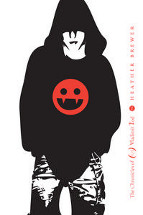Eighth grade bites by Heather Brewer

Penguin, 2010. ISBN : 978 0 143 20514 2
Suggested reading age 13-16. There is nothing special or imaginative in
this story which is first of five in The chronicles of Vladimir Tod
series. Heather Brewer has assembled all the usual elements of vampire
novels in the standard template applied by other authors of this genre.
Accordingly, it will be a roaring success with readers currently
devoted to the Twilight series and I'm sure they will clamour for the
next instalments. Vladimir is a teenaged orphan vampire living with his
'Aunt' Nelly who is an old friend of his mysteriously deceased parents
but not related. Nelly is completely comfortable with Vladimir being
half vampire, half human and preposterously tells him he is normal and
not weird or bizarre, despite the fact that she must steal enormous
quantities of blood from the hospital for him to drink. The only other
person knowing his secret is Henry, a lifelong friend who similarly has
no problems with the fact that Vlad occasionally lusts after human
blood. Within the supernatural context, Brewer casts her characters
with normal adolescent characteristics and behaviours. One can identify
readily with the schoolyard taunts and bullying directed at Vlad on the
grounds of his 'Goth' appearance and the reader understands his awkward
heart sick love for fellow student Meredith. The author struggled
terribly recounting Vlad's yearning to understand his vampire father
Tomas' past as he discovers documents and articles with hidden
significance. Written communications left by Tomas are clumsy,
contrived and completely unrealistic, as is the plot development
involving powerful forces responsible for his parents' death
threatening Vlad.
Descriptions of frozen blood snacks and blood infused lunches provided
by Aunty Nelly are stomach turning, occurring more frequently than
expected, even in such a story. Descriptions of death by blood sucking
vampires do of course occur, and whilst one hesitates to describe them
as tasteful, they are not unnecessarily graphic. Whilst my instinct is
to dismiss this novel as inane rubbish, clearly it will appeal to many
adolescent readers and will be valuable for engaging disinterested
students, especially since the language and themes are not difficult to
understand. Pleasingly the author dealt with a theme which is
inherently evil and dark whilst allowing goodness and human values to
be maintained in normal daily life and when faced by terror.
Rob Welsh